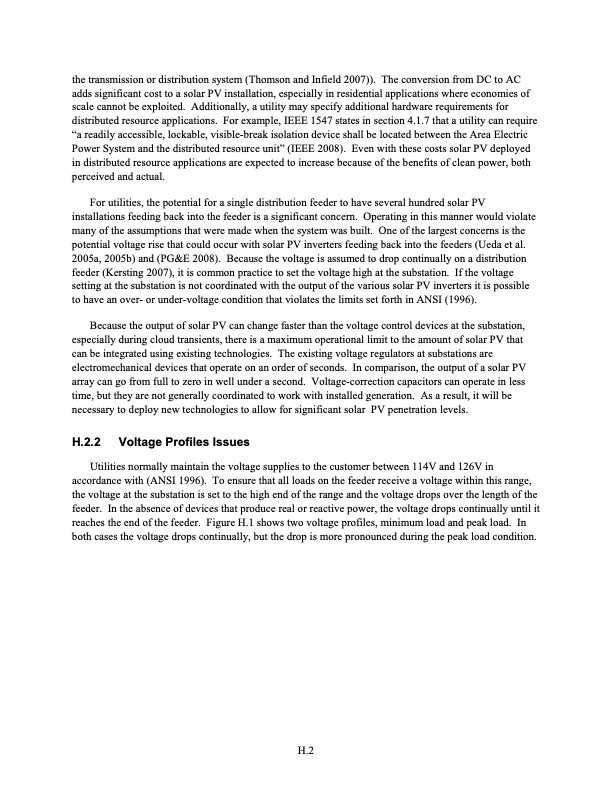
PDF Publication Title:
Text from PDF Page: 134
the transmission or distribution system (Thomson and Infield 2007)). The conversion from DC to AC adds significant cost to a solar PV installation, especially in residential applications where economies of scale cannot be exploited. Additionally, a utility may specify additional hardware requirements for distributed resource applications. For example, IEEE 1547 states in section 4.1.7 that a utility can require “a readily accessible, lockable, visible-break isolation device shall be located between the Area Electric Power System and the distributed resource unit” (IEEE 2008). Even with these costs solar PV deployed in distributed resource applications are expected to increase because of the benefits of clean power, both perceived and actual. For utilities, the potential for a single distribution feeder to have several hundred solar PV installations feeding back into the feeder is a significant concern. Operating in this manner would violate many of the assumptions that were made when the system was built. One of the largest concerns is the potential voltage rise that could occur with solar PV inverters feeding back into the feeders (Ueda et al. 2005a, 2005b) and (PG&E 2008). Because the voltage is assumed to drop continually on a distribution feeder (Kersting 2007), it is common practice to set the voltage high at the substation. If the voltage setting at the substation is not coordinated with the output of the various solar PV inverters it is possible to have an over- or under-voltage condition that violates the limits set forth in ANSI (1996). Because the output of solar PV can change faster than the voltage control devices at the substation, especially during cloud transients, there is a maximum operational limit to the amount of solar PV that can be integrated using existing technologies. The existing voltage regulators at substations are electromechanical devices that operate on an order of seconds. In comparison, the output of a solar PV array can go from full to zero in well under a second. Voltage-correction capacitors can operate in less time, but they are not generally coordinated to work with installed generation. As a result, it will be necessary to deploy new technologies to allow for significant solar PV penetration levels. H.2.2 Voltage Profiles Issues Utilities normally maintain the voltage supplies to the customer between 114V and 126V in accordance with (ANSI 1996). To ensure that all loads on the feeder receive a voltage within this range, the voltage at the substation is set to the high end of the range and the voltage drops over the length of the feeder. In the absence of devices that produce real or reactive power, the voltage drops continually until it reaches the end of the feeder. Figure H.1 shows two voltage profiles, minimum load and peak load. In both cases the voltage drops continually, but the drop is more pronounced during the peak load condition. H.2PDF Image | The Smart Grid: An Estimation of the Energy and CO2 Benefits

PDF Search Title:
The Smart Grid: An Estimation of the Energy and CO2 BenefitsOriginal File Name Searched:
PNNL-19112.pdfDIY PDF Search: Google It | Yahoo | Bing
NFT (Non Fungible Token): Buy our tech, design, development or system NFT and become part of our tech NFT network... More Info
IT XR Project Redstone NFT Available for Sale: NFT for high tech turbine design with one part 3D printed counter-rotating energy turbine. Be part of the future with this NFT. Can be bought and sold but only one design NFT exists. Royalties go to the developer (Infinity) to keep enhancing design and applications... More Info
Infinity Turbine IT XR Project Redstone Design: NFT for sale... NFT for high tech turbine design with one part 3D printed counter-rotating energy turbine. Includes all rights to this turbine design, including license for Fluid Handling Block I and II for the turbine assembly and housing. The NFT includes the blueprints (cad/cam), revenue streams, and all future development of the IT XR Project Redstone... More Info
Infinity Turbine ROT Radial Outflow Turbine 24 Design and Worldwide Rights: NFT for sale... NFT for the ROT 24 energy turbine. Be part of the future with this NFT. This design can be bought and sold but only one design NFT exists. You may manufacture the unit, or get the revenues from its sale from Infinity Turbine. Royalties go to the developer (Infinity) to keep enhancing design and applications... More Info
Infinity Supercritical CO2 10 Liter Extractor Design and Worldwide Rights: The Infinity Supercritical 10L CO2 extractor is for botanical oil extraction, which is rich in terpenes and can produce shelf ready full spectrum oil. With over 5 years of development, this industry leader mature extractor machine has been sold since 2015 and is part of many profitable businesses. The process can also be used for electrowinning, e-waste recycling, and lithium battery recycling, gold mining electronic wastes, precious metals. CO2 can also be used in a reverse fuel cell with nafion to make a gas-to-liquids fuel, such as methanol, ethanol and butanol or ethylene. Supercritical CO2 has also been used for treating nafion to make it more effective catalyst. This NFT is for the purchase of worldwide rights which includes the design. More Info
NFT (Non Fungible Token): Buy our tech, design, development or system NFT and become part of our tech NFT network... More Info
Infinity Turbine Products: Special for this month, any plans are $10,000 for complete Cad/Cam blueprints. License is for one build. Try before you buy a production license. May pay by Bitcoin or other Crypto. Products Page... More Info
| CONTACT TEL: 608-238-6001 Email: greg@infinityturbine.com | RSS | AMP |